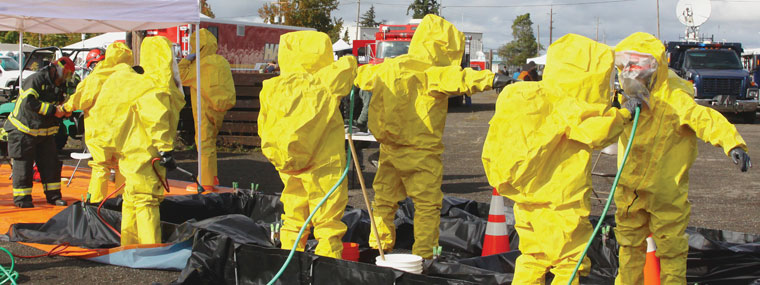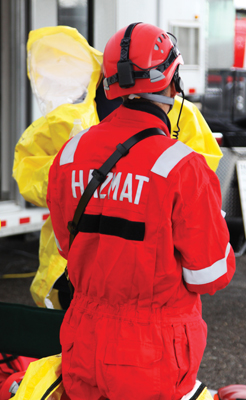
Preparing for and Responding to a Chemical Incident
By Diane M. Calabrese / Published February 2023

Temblors, tornadoes, and other forces of nature can upend the best day-to-day safety protocols. We all know that. Yet such knowledge does not give an owner a pass on preparation, as in “no matter what I do, something might happen anyway.”
Businesses must prepare for events that might happen. Incidents involving chemicals—spills, splashes, slips, etc.—pose serious risks to employees and other people. They demand serious attention to reporting details.
Roy G. Chappell, CEO of Chappell Supply and Equipment in Oklahoma City, OK, shares the consensus of some of his team members about priorities in preparation and response. (Team members are Danner Bitter and Brandon Griggs, CDL drivers; Christian Byford, safety manager; and Drew Harbour, general manager.)
“Hazwoper training is an essential component of being prepared,” says Chappell. Hazwoper is the acronym for hazardous waste operations and emergency response training.
“Hazardous waste is what is created in the incident of a spill, not just from the reactor down the road,” explains Chappell. “Hazwoper training highlights the importance of personal protective equipment, emergency response plans, development of call trees, and the key steps of prevention, preparedness, and recovery.”
A plan internalized by employees accelerates response. Employees know it so well they need not search for information in an acute situation.
A precise sequence of steps to follow reduces time-consuming deviation as well. “This standardizes the response and lowers the likelihood of error when an incident occurs, while waiting for emergency services or cleanup services to arrive,” says Chappell.
The what-comes-first list of responses to an incident should be obvious to employees. “The health and safety of employees and other people involved overrides all else,” explains Chappell. “People’s safety should be your highest priority in an incident. Property can be replaced, but people cannot.”
Preparation can be tested by drills and mock situations. But the real test is always the one everyone hopes never happens: an actual incident.
“The four things we always teach are being prepared, knowing how to respond, mitigating the effects, and then recovering from the incident,” says Doug Rucker, owner of DougRuckerStore.com LLC in Porter, TX. “How one responds will always indicate how prepared they are in training and dictates how they reduce or prevent damage and injury, which dictates the recovery.”
There is no question that team members must be able to respond to a chemical incident in the correct sequence. What to do first in a chemical incident is tied to an understanding of the chemical.
“Being educated on the chemical(s) that caused the incident is, in my mind, one of the most essential things to know,” says Rucker. “Knowing the harmful effects the chemical can have on not only your personnel but also the environment the incident occurred in. This will help all staff know how to respond and mitigate or prevent any possible damage or injury.”
When an incident does occur, it should become the focus of attention at a jobsite. “Alert those near and around the incident, assess the incident, and then proceed with your emergency plan as needed,” says Rucker.
It’s possible false alarms will be issued. For example, a container of chemical is not leaking, but because of ambient conditions a condensation of water has occurred, and the container is wet with water. Pausing to check the container thoroughly is a prudent action.
Several federal entities have purview over chemical incidents. They come at the preparation and response from slightly different perspectives. They are Department of Transportation (DOT), Environmental Protection Agency (EPA), Department of Health and Human Services (HHS), and of course, the Occupational Safety and Health Administration (OSHA) under the U.S. Department of Commerce.
It’s possible that a single incident could draw oversight response from every federal entity with a purview. Example: Hazardous material released on a roadway in a vehicular accident (DOT) that exposes the driver of an 18-wheeler (HHS, OSHA), even as it flows down an embankment and into a stream adjacent to the road (EPA).
Readers are aware of (OSHA) reporting requirements for any employee-involved incident. Reportable injuries (and illnesses) are those requiring more than first aid. If it is more than affixing a band aid to a paper cut, however, employers must weigh carefully whether reporting is required. Reporting requirements correspond to the hazard rating of an industry (more for more hazardous) and the size of the business (more for larger companies).
Where To Begin?
Prevention is always more effective than cure. Fortunately, though, prevention and preparation for an incident overlap.
Every bit of education that goes into training employees in the correct use of chemicals contributes to the foundation of preparation. Understanding of SDSs [safety data sheets], respect for chemicals—not only in use, but in storage and transport—and choice of the least toxic/dangerous chemical whenever possible are key elements. [See the related article in this issue on page 30, “Correctly Using Chemicals.”]
A six-page document from HHS short-handed as CHEMM [Chemical Hazardous Emergency Medical Management] (https://chemm.hhs.gov/quickresponseguide.htm) is designed as a quick response guide. With its conciseness, it serves as a valuable how-to-respond document.
The CHEMM quick guide enumerates six steps for initial response to a chemical hazmat (hazardous material) incident. The first one is to recognize the incident and activate the response.
Recognition is a softer way of noting the importance of not overlooking any event involving a chemical. “It’s just a small spill.” “I only got a little on my skin.” These and all the other let’s-just-ignore-it responses will not suffice. Action must be taken.
The second step, the first action, is to protect people. Then, decide what to do next (third step). Assessment may reveal the incident is contained, manageable, and not a hazard (e.g., a mild detergent spill).
But if the incident is serious, take action (step four) as indicated by the nature of the chemical. Stay in control of the situation (step five) until a responder arrives and a handoff of leadership (step six) can occur.
Yes, in general, the person who witnesses or discovers the chemical incident is the de facto leader of the response until professional responders arrive. The chemical incident will fit into one of three CHEMM categories: chemical hazmat, chemical mass exposure incident (MEI), or chemical weapons of mass destruction (WMD). [Generally, the last would not be suspected on a jobsite in our industry, but it is within the range of possibilities in 2023.]
Not all chemical hazmat incidents are detected by an observer noticing a release (leak, spill, etc.). Unexplained odors, plumes or mysterious fogs, a strange powder, or a puddle on the ground are all indicators of an incident. Human reactions to the unseen, such as watering eyes, skin irritation, or breathing difficulty, are also indicators of incidents. CHEMM quick guide provides a complete list of indicators.
Chemical MEI have stark indicators—multiple people “down” and in need of urgent care or dead—and are not difficult to recognize. Indicators for chemical WMD overlap some with hazmat and MEI, but they include some of a detective fiction nature, such as unexplained discarded PPE, unusual spraying in the area, and suspicious persons made so by taking a furtive departure.
Among the types and cues of chemical incidents, there is a tempering note on the CHEMM quick response guide. It is to consider other explanations.
In other words, don’t get carried away in assuming the worst. Rule out odors from nearby manufacturing plants and restaurants. Be sure meteorological conditions are not responsible for puzzling pools and low fog. And so on.
The level of federal involvement in response to a chemical incident coincides with the threat to the public. For instance, there is a threshold amount of chemical release that triggers mandatory reporting to EPA. If the threshold is met or exceeded, EPA assigns an on-scene coordinator (OSC).
The OSC monitors the cleanup—its appropriateness, timeliness, etc. It also has the authority to evaluate whether the party responsible for the incident is cooperative and acting within the bounds of best practices. Things can go wrong for the company responsible if it is deemed uncooperative, precipitating a federal National Response Team (NRT) takeover. The NRT brings in additional resources.
Obviously, a contractor, distributor, or manufacturer never wants to be involved in a chemical incident that brings in an NRT. (Oil spills almost always instigate the mobilization of an NRT.)
As far as the EPA is concerned, chemical incidents should be so rare and so small that they can be handled by a first line defense. That defense begins with the company responsible and any response contractors it summons, as well as local fire, police, and emergency responders if needed to assist.
To encourage companies that experience a chemical incident to obtain the assistance they need (or may need), EPA offers reimbursement up to $25,000 to local governments to defray costs involved in sending their safety and emergency personnel to an incident site.
Investment of time and money in preparing for and responding to a chemical incident brings a double return. Training provides good crossover to situations when earthquakes, tornados, or other forces of nature strike.






